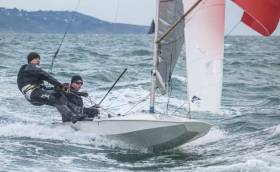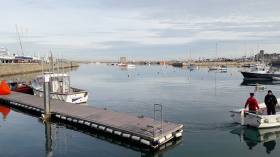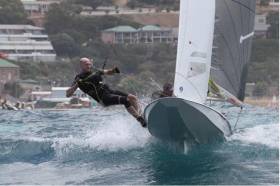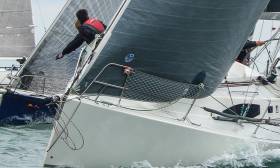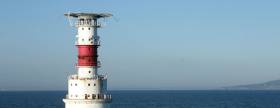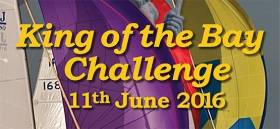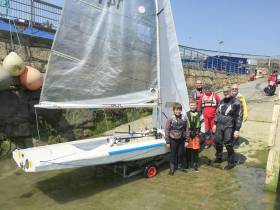Displaying items by tag: dmyc
Accurate Forecast Puts off Fireball Participation at DMYC?
Yesterday’s diminished Fireball fleet in DMYC’s Frostbite Series may have been a consequence of the actual weather mirroring the forecast writes Cormac Bradley. XCWeather had been predicting winds of 17 knots with gusts up to 28 knots from a WNW direction and that is what the weather station in the harbour was showing on my arrival – 20.1 knots, a gust of 28.6 knots, a wind direction of 295˚ and an air temperature of 10.6˚. While the air temperature may have been a balmy 10.6˚ for January, it still required a hat coat and gloves to stand and watch proceedings.
Three Fireballs were on the start line at the designated time, Messrs Butler and Oram (15061), the Clancy brothers (14807) and the “pink ladies”, McKenna & O’Keeffe (14691). Later they were joined by Frank Miller and (possibly) Ed Butler, but I am not sure if this latter combination would be ranked as a starter. (Official results today confirm they are both a starter and a finisher).
All three boats sailed to the left-hand-side of the course on the first beat with Team Clancy, Conor & James, the first to peel off to go right. From my vantage point it appeared that they had done the right thing by going right that bit earlier, but by hanging in that bit longer on the left, Noel & Stephen gave the impression of being able to sail that bit freer up the port lay-line to power over the brothers. Spinnakers were broken out on the legs from Mark 1 to Mark 2, but in reality the course was such that Mark 2 was almost incidental from an angles perspective. At the first rounding of Mark 2, Butler & Oram gybed, but all this seems to achieve was to set them up for another gybe to get round Mark 3, followed by another gybe at Mark 3 itself. Team Clancy sailed beyond and probably 20 - 30m outside Mark 2 before they put in their gybe to get to Mark 3. The leg from Mark 3 to Mark 4 proved to be too tight for spinnakers.
On the second beat the lead pair, with Butler & Oram comfortably ahead, sailed on the RHS to the harbour mouth, relative to a weather mark that was of the order of 100-120m to the west of the end of the West Pier. This time Butler was the first to cross the course with Team Clancy hanging on to the outer edges of the course. By the time Butler & Oram reached Mark 4 the second time they had a leg lead on the Clancys. On the third beat, the pair split, with Butler going left and early on it looked as though Clancy may have closed the gap. However, when they actually crossed tacks Butler was still comfortably ahead. On the following beat, they took opposite sides again, except Butler went right this time. It made no difference as the lead was maintained.
Mark 2 had less and less of a role to play in the race as the laps passed, increasingly the lead two boats, flying spinnaker, sailed further and further outside of Mark 2, extending the starboard tack three sail reach to beyond the HSS terminal before putting in a gybe for a short hitch to Mark 3 and a spinnaker drop to two-sail to Mark 4. The “pink Ladies”, Louise and Hermine obviously decided that discretion was the better part of valour and kept their spinnaker in its bag for the day. Ditto Messrs Miller & Butler.
| DMYC Frostbites 2016/17: Series 2 | R1 | R2 | Tot. | |||
| 1 | Noel Butler & Stephen Oram | 15061 | NYC | 3 | 1 | 4 |
| 2 | Louise McKenna & Hermine O’Keefe | 14691 | RStGYC | 2 | 3 | 5 |
| 3 | Frank Miller & Ed Butler | 14713 | DMYC | 4 | 4 | 8 |
| 4 | Louis Smyth & Joe O’Reilly | 15007 | Coal Harb. | 1 | 13 | 14 |
| 5 | Conor & James Clancy | 14807 | RStGYC | 13 | 2 | 15 |
DMYC Frostbite Last Race…First Cancellation!
Considering the time of year, it is rather surprising that we have got to the end of Series 1 of the Dun Laoghaire Motor Yacht Club’s Frostbites without a cancellation……….until the last Sunday, writes Cormac Bradley. Competitors were greeted with a mirror-like seascape inside the harbour with no motion from the flags around the periphery of the harbour. Those on the flagstaff of the host club were so limp that they couldn’t be recognised. On the opposite side of the inner reaches of the harbour, brand flags from the yacht brokers were likewise hanging limp.
Frostbite co-ordinator Olivier Proveur however decided that with the day that was in it, an attempt should be made to race and slightly behind schedule, understandably, the fleet was ordered to go afloat. Not everyone complied, but those that did faced a long paddle out to the race area. This correspondent was one of the last to go down the slipway but before he needed to get his feet wet, a radio communication was received to the effect that racing was cancelled.
This prompted an early prize-giving where calendars with pictures from the Frostbites were the prizes. Frostbite co-ordinator Olivier added his own form of wit to these proceedings which were preceded by the serving of finger food and soup.
The Frostbites take a break now with no racing on the next two Sundays – Christmas Day and New Year’s Day. We resume on 8th January 2017.
| 2016/17 DMYC Frostbites – Series1: After 2nd Discard. | R1 | R2 | R3 | R4 | R5 | R6 | R7 | R8 | R9 | Nett | |
| Noel Butler/Phil Lawton & Stephen Oram/Ger Owens | 15061 | 1 | 1 | 1 | 1 | 1 | 1 | 2 | 2 | 1 | 7 |
| Conor Clancy/Owen Laverty & James Clancy | 14807 | 2 | 4 | 2 | 4 | 3 | 13 | 1 | 1 | 4 | 17 |
| Neil Colin & Margaret Casey | 14775 | 13 | 2 | 4 | 2 | 2 | 5 | 3 | 3 | 6 | 21 |
| Louise McKenna & Hermine O’Keeffe/Cormac Bradley | 14691 | 3 | 3 | 7 | 7 | 5 | 4 | 4 | 4 | 7 | 30 |
| Frank Miller & Ed Butler/Cormac Bradley/Grattan Donnelly | 14713 | 13 | 5 | 6 | 8 | 6 | 2 | 6 | 5 | 2 | 32 |
| Alistair Court & Gordon Syme/Cormac Bradley | 14706 | 13 | 13 | 13 | 5 | 4 | 3 | 5 | 9 | 5 | 44 |
| Louis Smyth & Joe O’Reilly/Glenn Fisher | 15007 | 13 | 7 | 3 | 3 | 7 | 11 | 13 | 13 | 3 | 47 |
| Cariosa Power & Marie Barry | 14854 | 13 | 6 | 8 | 6 | 8 | 7 | 13 | 13 | 13 | 61 |
| Peter & Michael Keegan | 14676 | 13 | 8 | 5 | 13 | 13 | 8 | 8 | 7 | 13 | 62 |
| Mary Chambers & Brenda McGuire | 14865 | 13 | 13 | 13 | 9 | 9 | 11 | 7 | 6 | 13 | 68 |
| Darragh McDonagh & Crew | 15058 | 13 | 13 | 13 | 13 | 13 | 6 | 13 | 13 | 13 | 84 |
| David Turner & Peter Doherty | 14362 | 13 | 13 | 13 | 10 | 10 | 13 | 13 | 13 | 13 | 85 |
From this correspondent, Happy Christmas to all!
Fireball Optimism Pays Off At DMYC…But Only Just!
The penultimate Sunday of Series 1 of the DMYC’s Frostbite Series 2016/17 saw a mirror-like appearance on the inner reaches of Dun Laoghaire harbour and the light air nature of the day was confirmed as the” keelers”, sailing their Turkey Shoot race were only just moving outside the harbour.
Despite this scenario, the principal organiser of the racing was heard to say that a single race would be sailed, of five laps, but that a shortened course signal would be close at hand. This correspondent, sailing with Alistair Court, was towed out to the race area by RIB and other Fireballs paddled & sailed in order to get to the start area. Given that the principal organiser, Olivier Proveur, is French, it seemed appropriate to say “Nous somme ici, mais pourquoi”, which I hoped translated to “We are here now, but why” as we drew alongside the committee boat. There was no apparent wind on the water and the Race Officer & Olivier were on the bow with a burgee, seeking some form of indication as to where a weather mark might go!
Eventually a few zephyrs made their presence felt and a weather mark was put in place just to the north of the approach to the marina, suggesting that what little wind there was was coming from a westerly direction. Mark No. 2 was located just off the HSS gantry with Marks 3 & 4 down towards the East Pier Wall, with 4 about 50-60m inside the end of the East Pier.
No-one was straying too far from the start line in the fickle winds that were blowing and our assessment was to pick a spot to start and see how the wind gods treated us. Clearly, we got this wrong as minutes after the start, we were stone last. Three boats hogged the pin-end on port tack, Frank Miller & Grattan Donnelly (14713), Neil Colin & Margaret Casey (14775) and Noel Butler & Stephen Oram (15061). Slightly behind them, also on port were the Clancy brothers, Conor & James, (14807), and between the pin and the committee boat end were Louis Smyth & Glenn Fisher (15007) and the “pink-ladies”, Louise McKenna & Hermine O’Keeffe (14691), so called because of their matching pink woolly hats.
For a change, Butler & Oram were not the leading boat; that went to Colin & Casey, who also lead the fleet round the first weather mark in the second race last Sunday, but weren’t credited for the achievement in the corresponding report. Next came Miller & Donnelly followed by Butler & Oram, but as the wind switched off, the tail-enders caught up with the leaders and all seven boats rounded in a relatively short window. No-one bar Smyth & Fisher tried to fly spinnakers and Miller, taking a hitch to windward was rewarded when he overtook Colin to lead around Mark 2.
In the lightest of winds, places changed quite regularly between Marks 1 & 3 with a wide variety of approaches being taken to Mark 3. Colin for example gybed immediately at Mark 2 to sail a course inside the trapezoid. Court went out wide with Clancy, towards the East Pier, while Smyth and McKenna sailed more of a straight line course to Mark 3. By 3, Clancy had gone ahead of Court who then found that both Smyth and McKenna had water on him at the mark so he took a slow rounding for his pain. Colin had dropped further back.
The passage from 3 to 4 was “trying”. Miller & Donnelly led past 3 and onto 4 where, assuming a beat to 1, they dropped spinnaker. Butler & Oram decided that bag could be flown thus giving the hint to everyone else. The Clancys, sailing higher than the rest of the fleet, carried it the furthest, but no-one managed to hold it all the way. Smyth & Fisher having sailed a positive 2 to 3 to 4 were now in third place, without really closing on the front two where Miller was still the rabbit to Butler’s greyhound. The top leg of the trapezoid was a “two-sailer” again and had more of a beat to it as more than one boat took a hitch to try and get into clear wind. Miller was still leading at 2 and held that until very late on when Butler was able to make a faster manoeuvre at Mark 4 when a shortened course was signalled.
Smyth & Fisher took third, Clancys fourth and Court & Bradley and Colin & Casey were overlapped going over the line with Court getting the nod.
| 2016/17 DMYC Frostbites – Series1: After 2nd Discard. | R1 | R2 | R3 | R4 | R5 | R6 | R7 | R8 | R9 | Nett | |
| Noel Butler/Phil Lawton & Stephen Oram/Ger Owens | 15061 | 1 | 1 | 1 | 1 | 1 | 1 | 2 | 2 | 1 | 7 |
| Conor Clancy/Owen Laverty & James Clancy | 14807 | 2 | 4 | 2 | 4 | 3 | 13 | 1 | 1 | 4 | 17 |
| Neil Colin & Margaret Casey | 14775 | 13 | 2 | 4 | 2 | 2 | 5 | 3 | 3 | 6 | 21 |
| Louise McKenna & Hermine O’Keeffe/Cormac Bradley | 14691 | 3 | 3 | 7 | 7 | 5 | 4 | 4 | 4 | 7 | 30 |
| Frank Miller & Ed Butler/Cormac Bradley/Grattan Donnelly | 14713 | 13 | 5 | 6 | 8 | 6 | 2 | 6 | 5 | 2 | 32 |
| Alistair Court & Gordon Syme/Cormac Bradley | 14706 | 13 | 13 | 13 | 5 | 4 | 3 | 5 | 9 | 5 | 44 |
| Louis Smyth & Joe O’Reilly/Glenn Fisher | 15007 | 13 | 7 | 3 | 3 | 7 | 11 | 13 | 13 | 3 | 47 |
| Cariosa Power & Marie Barry | 14854 | 13 | 6 | 8 | 6 | 8 | 7 | 13 | 13 | 13 | 61 |
| Peter & Michael Keegan | 14676 | 13 | 8 | 5 | 13 | 13 | 8 | 8 | 7 | 13 | 62 |
| Mary Chambers & Brenda McGuire | 14865 | 13 | 13 | 13 | 9 | 9 | 11 | 7 | 6 | 13 | 68 |
| Darragh McDonagh & Crew | 15058 | 13 | 13 | 13 | 13 | 13 | 6 | 13 | 13 | 13 | 84 |
| David Turner & Peter Doherty | 14362 | 13 | 13 | 13 | 10 | 10 | 13 | 13 | 13 | 13 | 85 |
Next Sunday, 18th, sees the last race of Series 1.
Meanwhile in sunny South Africa, the Fireball Worlds got underway in strong wind, big seas and sunshine in Mossel Bay on the country’s Garden Route.
At the Pre-Worlds last week, which doubled up as the South African Class Nationals, the Swiss pair of Claude Mermod & Ruedi Moser, current European Champions, (SUI 14799) had a perfect week winning all bar one of the races, the last, which they didn’t need to sail. The last race win went to Ben Schulz and Jack Lidgett (AUS 15113), allowing them to finish second overall, ten points adrift of the Swiss. Third overall were Johana Koranva Napravnikova & Jakub Napravnik (CZE 15109) who scored two seconds in a nett score of 17 points. The early part of the Pre-Worlds was heavy winded with Day 1 seeing no racing. However, it seems that by the end of the week a lack of wind was the bigger problem.
After a flag-raising ceremony yesterday morning, the Worlds fleet went out in big winds and even bigger seas. The Swiss paid “second fiddle” to reigning World Champions, Tom Gillard & Richard Anderton (GBR 15127), with Schulz & Lidgett, third. Facebook posts show huge seas, high speed Fireballing and Fireballs cresting waves with half their hulls out of the water. The matching reports suggest an exhilarating day but tired bodies as a consequence.
Fireball Frostbites Underway, AGM Elects New Chairman
The 2016/17 Dun Laoghaire Motor Yacht Club Frostbites got off to a blustery start this afternoon in Dun Laoghaire. The weather station adjacent to my observation point had the various weather parameters as follows; Wind Direction - 345˚, Wind 19.6 knots, Gust 28.5 knots and Air Temperature 9˚. In truth it didn’t appear to be as cold as the Saturday when this correspondent sailed three races in a Flying Fifteen wind while there was more sunshine for that session, the weather today was cloudy but seemed to be a little warmer – but it wasn’t “shirt sleeve weather” by any means.
Three Fireballs graced the opening day of the Series – Noel Butler & Stephen Oram (15061), Conor & James Clancy (14807) and Louise McKenna & Hermine O’Keeffe (14691). The overnight Met Eireann forecast didn’t hold out much hope of racing with a projected Force 5 – 8 for all parts of the Irish Seas and indeed by Sunday morning a Facebook post to the fleet suggested that some consideration had been taken as to whether racing would be possible.
Noel & Stephen comfortably won the race from Conor & James with the ladies finishing third. In truth I missed most of the action on the water as I was delayed getting to the harbour. It was a day of discretion being the better part of valour with respect to spinnaker flying.
The start area was in the vicinity of the dormant berth for the HSS with a weather mark towards the end of the West Pier. The top and bottom reaches of the trapezoid course were moderately short in comparison to the beat and run. Given the news of the revised planning permission for a cruise liner berth in the harbour this past week, it will be interesting to see how this impacts on the Frostbite and other sailing activity inside the harbour.
In other Fireball news the Class had its AGM on the Saturday night of the last regatta of the year. As had been signposted there was a change of Chairman with Marie Barry standing down after a three-year stint. In terms of falling numbers at events, Marie has not had it easy, but she has put a lot of effort into the Class and is due our collective thanks. Marie is replaced as Class Chairman by Neil Cramer of Skerries Sailing Club. Regatta participants would know Neil as the crew to Niall McGrotty. Margaret Casey had also indicated her intention to retire as Class Secretary. By my reckoning Margaret has been Secretary to at least three Chairmen, Marie, Neil Colin and I, and this period alone accounts for 9 years of service. Marie Barry has taken on the mantle of Secretary. Conor Clancy will continue as Treasurer.
Since the AGM there has been a committee meeting and individual activity in getting the calendar fixed for next year. In addition to our normal roster of events, with 2017 being an odd-numbered year, there will be a three day Volvo Dun Laoghaire event over the first weekend of July. Next year’s Fireball Europeans are scheduled for August in Lyme Regis on the English South Coast. Given their proximity, there is an expectation of Irish participation.
Finally, the end of year prize-giving will take place in the National Yacht Club on Friday 25th November.
J109 Sets Course Record in Big Turnout for DMYC Kish Race
Today's winner of the DMYC Kish race from Dun Laoghaire harbour reached the lighthouse on the edge of Dublin Bay in approximately 51–minutes. The J109 Jalapeno may have completed what organisers believe is a course record in the blustery westerly conditions that prevailed. A full photo gallery is here.
On the return leg, a squall blew through the course with 30–plus knots recroded, resulting in 14 boats retiring.
The 41–boat fleet included a wide variety of craft, including many cruisers who never normally race, according to race organisers, Olivier Prouveur and Neil Colin.
Results are below as a PDF file. Photo gallery is here.
Windy DMYC Kish Race Photo Gallery
A fine fleet of mixed sailing cruisers braved south–westerly winds gusting to gale force on Dublin Bay today for the ten–mile Round Kish Lighthouse Race. The DMYC race started at 11am and included many Dublin Bay boats but also visitors from Greystones and Howth. Photo gallery below:
Final Call For DMYC Kish Race, 26 Boats Entered So Far
The DMYC in Dun Laoghaire are reminding sailors that online entry for its Kish race on Dublin Bay closes tomorrow at 19.00 on 24th September.
Looking at the weekend forecast – sailing tomorrow may will be for the heavy weather brigade, but Sunday shows some easing even though the WindGuru is predicting gusts in the low 20’s. Does it suggest a spin around the Kish on Sunday would be an ideal way to close out the season?
'The Kish might not be the Vendee Globe, but it still presents a challenge all sailors like', says DMYC's Neil Colin.
DMYC Kish Lighthouse Race Details Are Announced
The DMYC will hold its annual Dun laoghaire to Kish lighthouse (and back) race on Sunday 25th September.
The DMYC have been staging this race since the early 1980’s when it was a single–handed affair and over more recent years it has become a two–handed race, but in this instance the club hopes there will be a greater participation as a fully crewed race, which might suit the potential autumn conditions better than the historic mid-summer conditions.
The race is also being run under Echo Standard, as compared to the adjusted echo for two reasons. Firstly, so that crews who have had their handicaps reduced due to performance, can enjoy a chance to race on the yachts design handicap, and have a chance of glory. Secondly, To encourage the cruising sailors who shy of formal racing and don’t have IRC or current Echo handicaps to participate.
The online entry form is also designed to accept entries from yachts who are not aware of their ECHO, as additional encouragement to sailors who may be more cruising orientated.
The event is open to all yachts, subject to insurance and standard DBSC Safety Requirements, which all competent yachtsmen should be meet in any event. The DMYC encourages entries from the greater Dublin Bay and East Coast area along with the White Sail fleets.
The Notice of Race and Entry form is here
100 Enter DMYC's King of the Bay Challenge Tomorrow
The DMYC say a late surge in entries means nearly 100 boats will race for their King of the Bay Challenge tomorrow, offering the cruisers a semi–coastal race and the dinghies a combination of a pursuit race and a standard handicap race. The on line entry system shuts down at 22.00 hours, so some time left this evening.
The question of whether a foiling moth can catch an IDRA with a forty two minute head start, after the IDRA has raced eighty three minutes will be answered. Who wins the Tortoise or the Hare ?
Fireball Dinghy Fun Sailing at DMYC
A touch of cradle-snatching on Saturday at DMYC where Fireballs threw out an open invite to sailors to try out the dinghy. Daniel Hrymak (12) and his friend Mark Henry (12) rocked up and went out for a spin.The light winds and hazy sunshine provided a gentle introduction for the duo whose main experience to date was Toppers and Laser 4.7s.They took to the boat like proverbial ducks and before long had got the hang of trapezing, stretching out into the gusts like experienced crews, hands free.. Both young sailors also got to helm and quickly found their stride.
Off wind spinnakers were set and they got their first taste of trimming gybing and dropping the kite. Meanwhile another participant Micheal Matulka sailing with Stephen Oram was put through his paces.
The regular keelboat sailor was enjoying his second outing in a Fireball and was seen quickly improving his trapezing and crewing techniques. On this occasion he got out on the wire with kite up, surely the most fun phase of sailing for any crew. The only things missing were decent waves and a bit more wind to add extra spice. This fun day was designed to get new sailors out in Fireballs to let them see what an exciting, yet stable and fun boat the Fireball is. The class, who are keen to attract new sailors, intend to run a couple more open sessions during the summer.




























